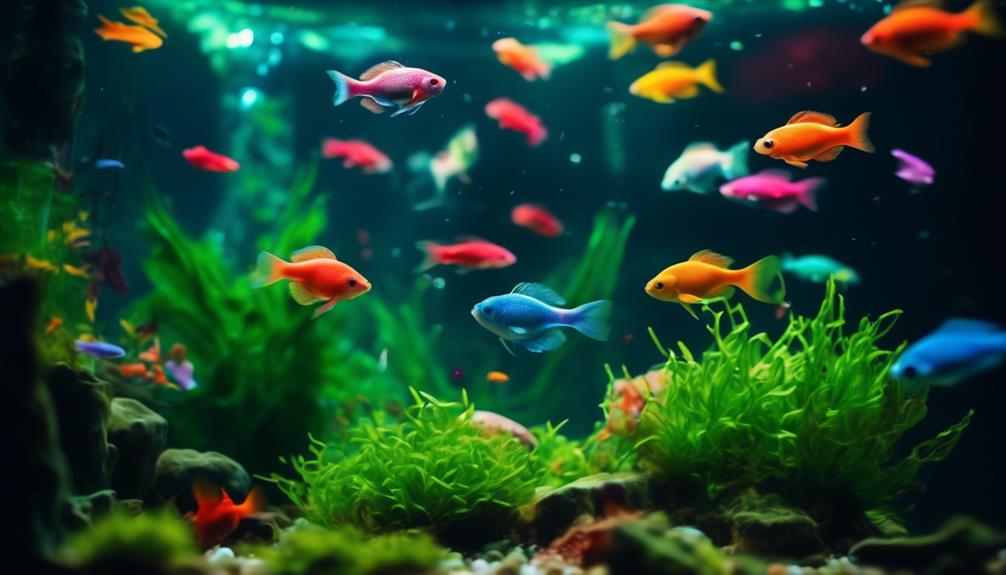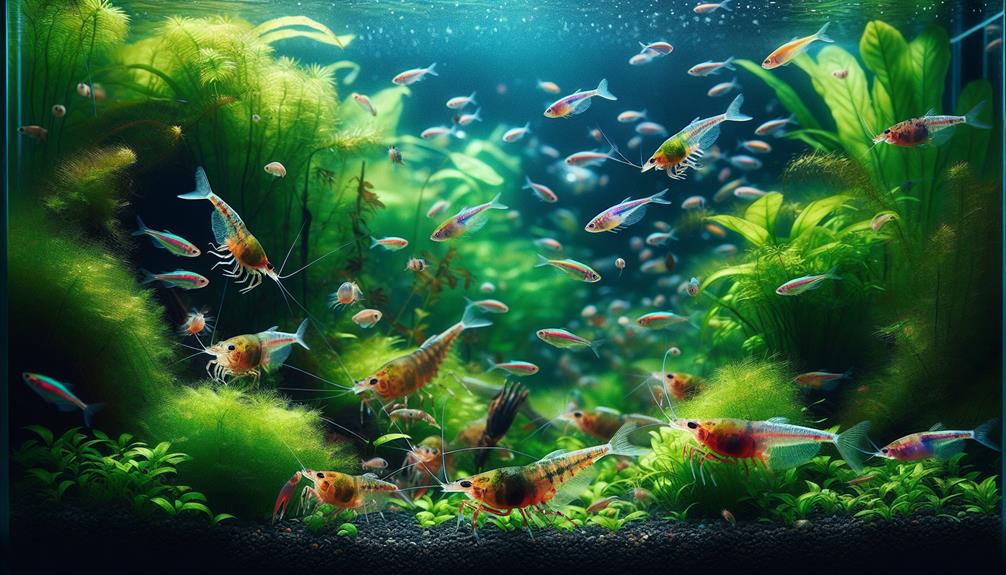Maintaining an aquarium can be a daunting task, but with the help of nature's tidying squad, you can transform your aquatic haven into a pristine and thriving ecosystem.
These remarkable organisms, ranging from sharks and eartheaters to flagfish and corydoras, possess unique abilities that make them excellent cleaners in different aspects of aquarium maintenance. From scavenging excess food to devouring algae and debris, they not only contribute to the overall cleanliness of your aquarium but also add diversity and beauty to your underwater world.
In this article, we will explore a range of species that make fantastic clean-up crews, leaving you with a sense of anticipation as we uncover the secrets behind how these creatures can revamp your aquarium.
Key Takeaways
- Sharks, such as rainbow sharks and redtail sharks, can act as clean-up crew in aquariums by eating excess food and algae.
- Eartheaters, like South American cichlids, are bottom-dwelling fish that filter out edible leftovers by scooping up substrate, preferably sand.
- Flagfish, with their unique mouth shape, are effective at removing hair algae and black beard algae, but they may damage delicate plants.
- Corydoras, peaceful scavengers, search for scraps in the substrate and are helpful in removing uneaten food that gets past surface eaters.
Sharks as Clean-Up Crew
Sharks, such as rainbow sharks and redtail sharks, play a vital role as scavengers in aquariums, efficiently cleaning up excess food and algae. These different species of sharks serve as a natural clean-up crew, helping to maintain a clean and healthy environment for other tank inhabitants.
When considering sharks for aquarium clean-up, it is important to keep in mind that only one shark should be kept in a 29-gallon or larger aquarium due to their territorial behavior.
Rainbow sharks come in variations such as black, albino, and Glofish colors, offering aesthetic appeal along with their cleaning abilities. Redtail sharks, on the other hand, are great scavengers for larger aquariums with similarly sized tank mates.
Eartheaters for Substrate Cleaning
While sharks are effective scavengers for cleaning up excess food and algae in aquariums, another group of fish, known as eartheaters, can also play a crucial role in substrate cleaning. Using eartheaters for substrate cleaning offers several benefits and considerations:
- Natural Substrate Cleaning: Eartheaters, South American cichlids, have a unique feeding behavior where they scoop up substrate to filter out edible leftovers. This process helps to keep the substrate clean and free from debris.
- Preference for Sand: Eartheaters prefer sand over gravel as it allows them to sift through the substrate more easily. Providing a sand substrate will facilitate their natural cleaning behavior.
- Tank Size and Compatibility: It is important to house eartheaters in a 55-gallon or larger community tank. They should be added as bottom-dwellers and kept with compatible tank mates that won't compete for food or cause aggression.
To properly care for and maintain a healthy eartheater population, it is crucial to provide a suitable environment with proper tank size, substrate, and compatible tank mates. Regular monitoring of water parameters and maintaining a balanced diet will also contribute to the overall health and well-being of these substrate-cleaning fish.
Flagfish for Algae Control

Flagfish, known for their distinctive pattern resembling the US flag, are an excellent choice for controlling algae in your aquarium. These North American fish have a unique mouth shape that allows them to pull off hair algae and black beard algae, making them effective cleaners.
However, it is important to note that while they are great at algae control, they can damage delicate plants while cleaning. To ensure the compatibility of flagfish in your aquarium, it is recommended to keep them in a 20-gallon or larger tank with other fast tank mates.
Additionally, flagfish can live in unheated aquariums, providing an easy option for algae control. Incorporating flagfish into your aquarium can be one of the best algae control methods, promoting a clean and healthy environment for your aquatic pets.
Corydoras as Scavengers
Corydoras, a type of peaceful scavenger, are highly efficient at searching for and consuming scraps, worms, and crustaceans that reside in the substrate of the aquarium. They work diligently to keep the tank clean and free of debris.
Here are three important aspects to consider when incorporating Corydoras into your aquarium:
- Breeding Habits: Corydoras are known for their interesting breeding behavior. They lay their eggs in a carefully constructed nest, usually on broad leaves or the glass surface of the aquarium. After the eggs are fertilized, the male guards the nest until the fry hatch. It is important to provide suitable breeding conditions, such as hiding places and proper water parameters, to encourage successful breeding.
- Tank Mates: Corydoras are generally peaceful and can be kept with a variety of tank mates. They are compatible with most community fish, as long as they are not aggressive or too large to pose a threat. Avoid keeping them with fin-nipping fish, as Corydoras have delicate fins. Also, be mindful of bottom-dwelling fish that compete for the same food sources, as this may lead to inadequate nutrition for the Corydoras.
- Variety and Sizes: Corydoras come in various varieties and sizes. Some popular species include Corydoras aeneus, Corydoras sterbai, and Corydoras panda. It is important to research the specific needs and characteristics of the species you choose to ensure they are suitable for your aquarium setup. Additionally, consider the size of your tank when selecting Corydoras, as some species require more space than others.
Platies for Ground Maintenance

Platies, known for their insatiable appetites and ability to pick at the ground, plants, and decor, are excellent additions to your aquarium for efficient ground maintenance. These livebearers possess a similar mouth shape to pull off algae and grab hidden food, making them ideal for algae control within the tank. They tirelessly work to keep the substrate clean by constantly foraging for food scraps and algae.
Additionally, platies reproduce readily and can fit into different nooks and crannies, ensuring that no area goes untouched.
While platies are great for ground maintenance, snails are also important for waste removal. Snails, such as ramshorn, nerite, and Malaysian trumpet snails, eat fish waste, algae, and rotting leaves, contributing to a cleaner and healthier aquarium environment.
Frequently Asked Questions
Can I Keep Multiple Sharks in a 29-Gallon Aquarium?
Keeping multiple sharks in a 29-gallon aquarium is not recommended due to their territorial behavior. However, there are alternative fish suitable for a tank of this size, such as rainbow sharks, redtail sharks, and a variety of other colorful and active fish species.
How Often Should I Perform Water Changes in a Tank With Eartheaters?
Performing regular water changes in a tank with eartheaters is essential for maintaining water quality. It is recommended to perform weekly water changes of 25-30% to ensure optimal breeding habits and to provide the best tank mates for eartheaters.
Do Flagfish Eat Live Aquarium Plants?
Flagfish are known for their ability to clean algae, including hair algae and black beard algae. However, they can damage delicate live aquarium plants while doing so. Consider alternative plant options or provide them with fast tank mates to minimize plant damage.
What Is the Ideal Tank Size for Corydoras?
The ideal tank size for corydoras depends on the specific species, but generally a 20-gallon or larger aquarium is recommended. Corydoras are peaceful scavengers that thrive with compatible tank mates and prefer a spacious environment for breeding habits.
How Can I Prevent Platies From Overpopulation in My Aquarium?
To prevent platies from overpopulating in your aquarium, implement effective breeding management strategies. This can include separating males and females, controlling food availability, and providing hiding places for fry. Regularly monitor and adjust these measures to maintain a healthy population.
Conclusion
In conclusion, nature's tidying squad offers a diverse range of species that can effectively maintain and revamp your aquarium.
From the efficient clean-up abilities of sharks and eartheaters to the algae controlling capabilities of flagfish and the scavenging nature of corydoras and platies, these organisms contribute to the overall cleanliness and aesthetic appeal of your aquatic habitat.
With their unique characteristics and abilities, these remarkable creatures provide an essential role in the maintenance and care of your aquarium ecosystem.

